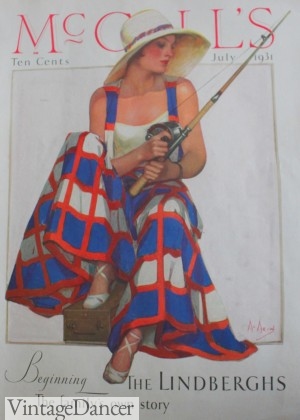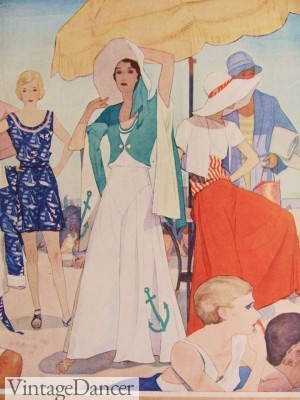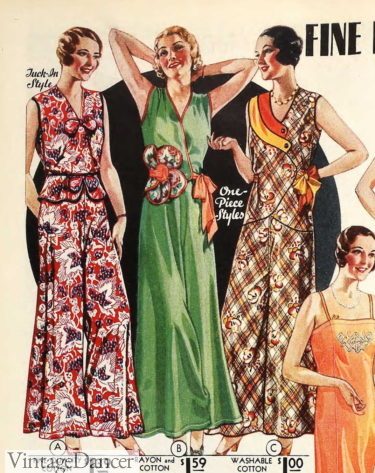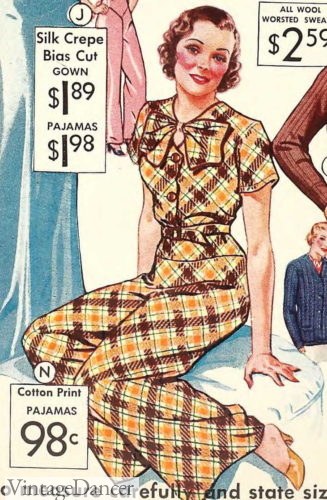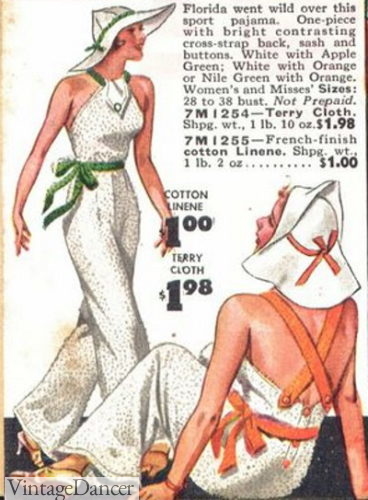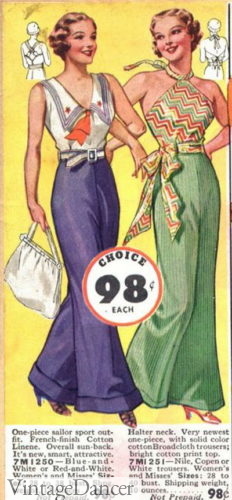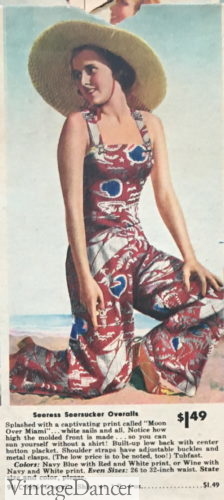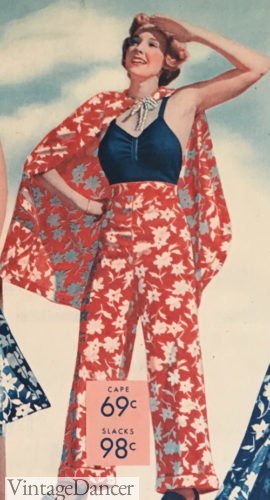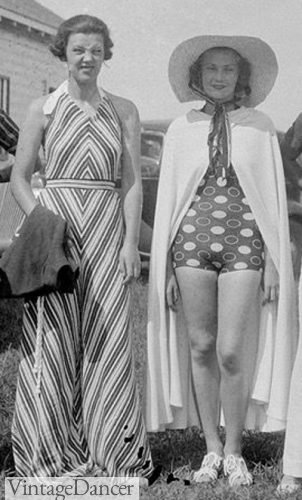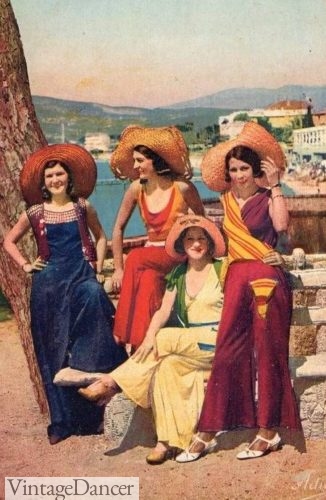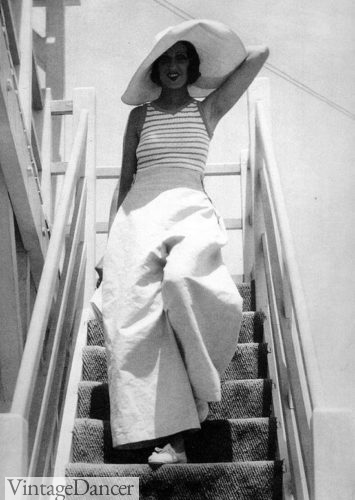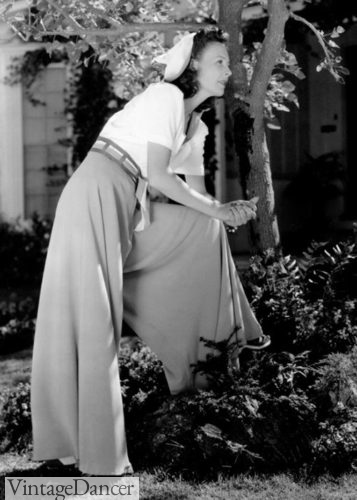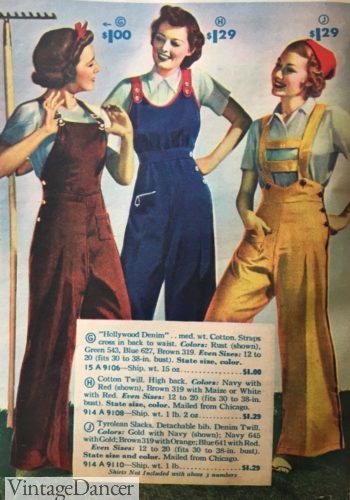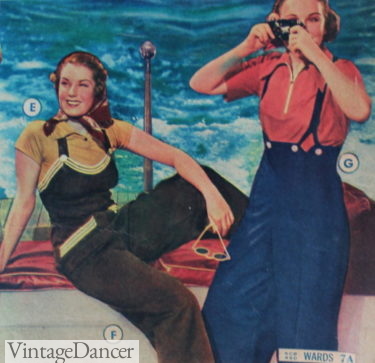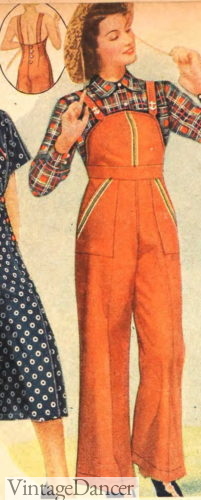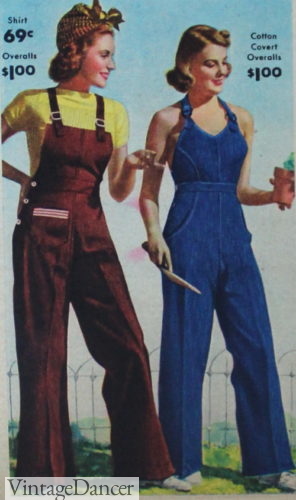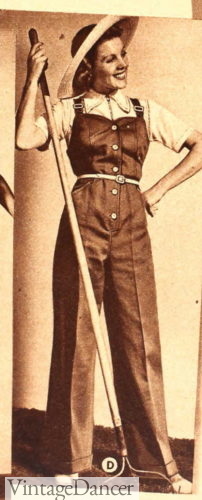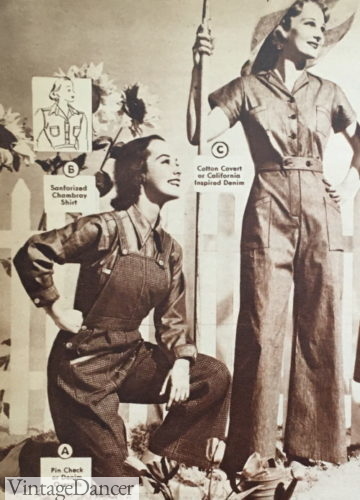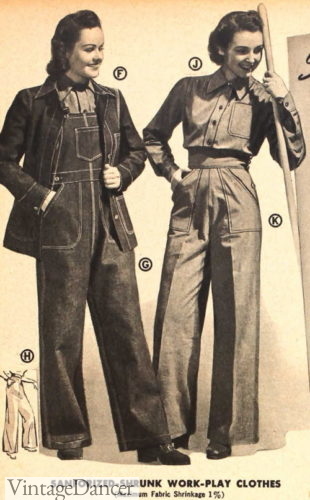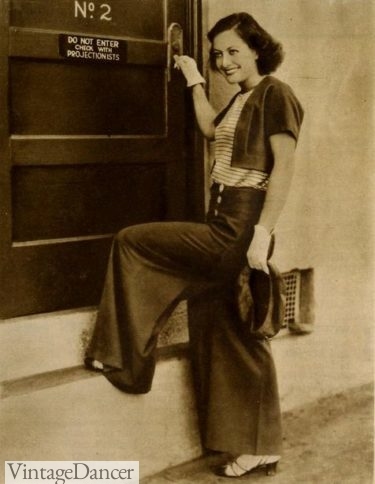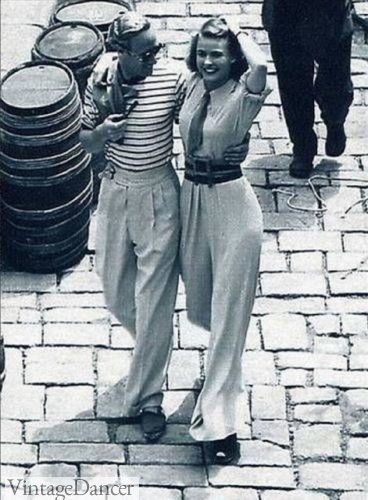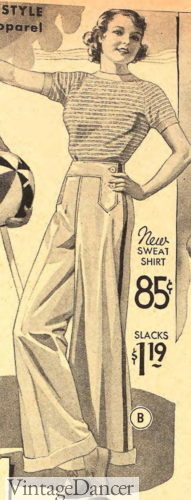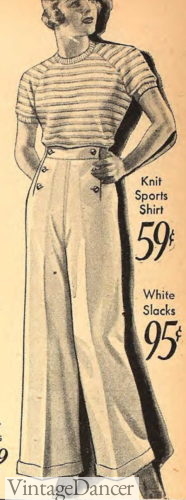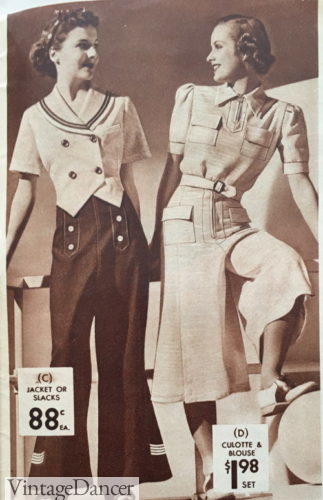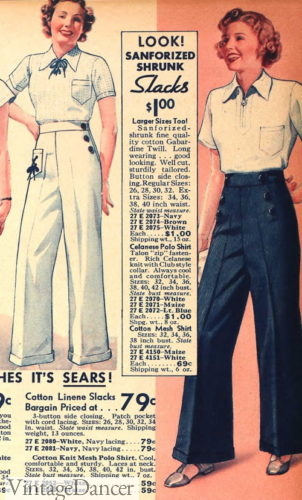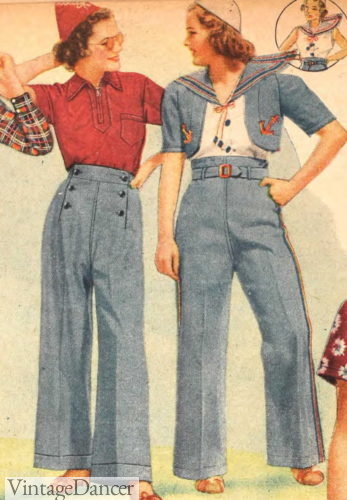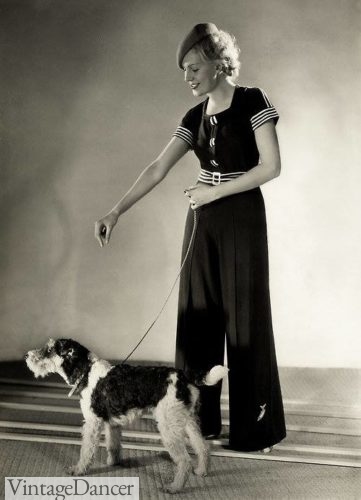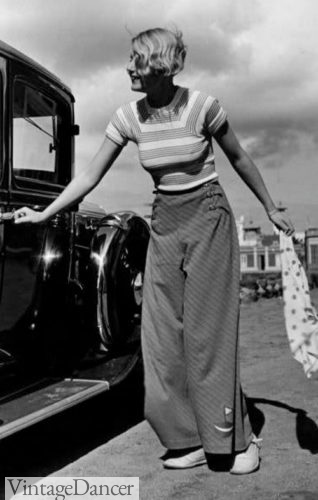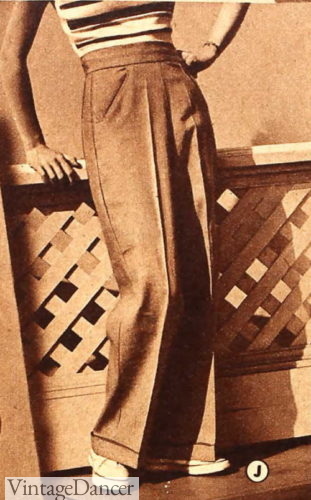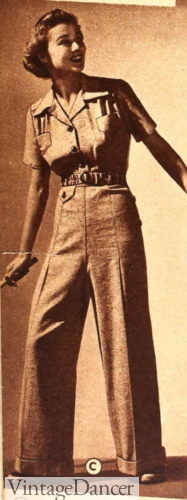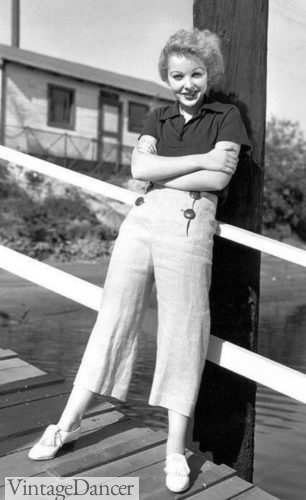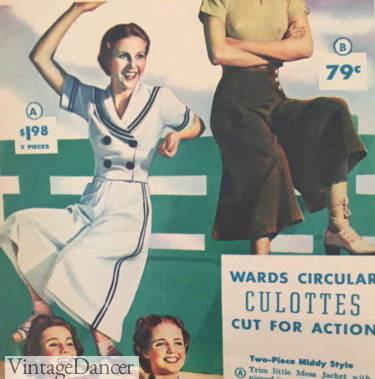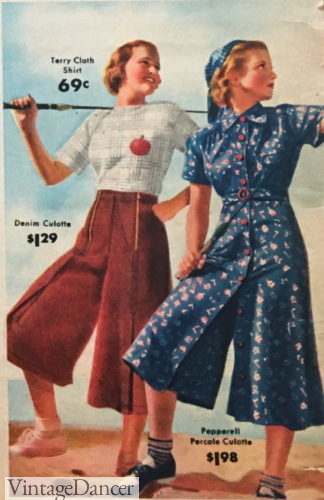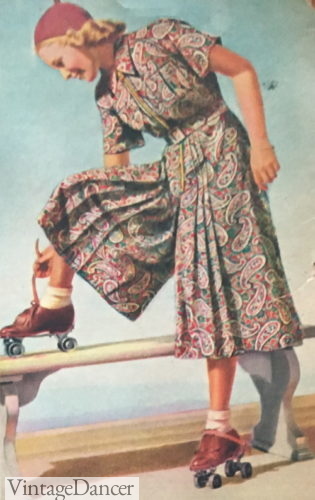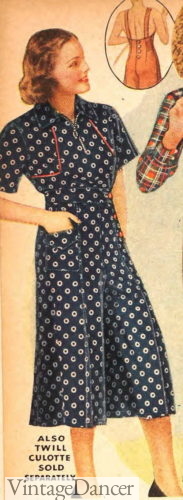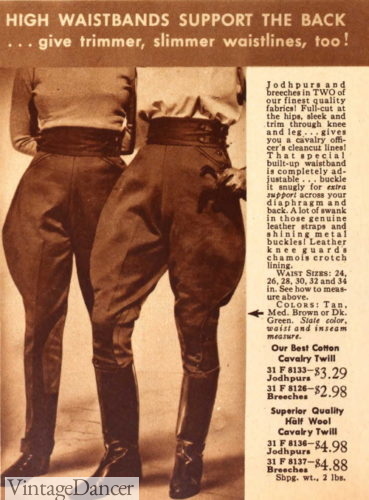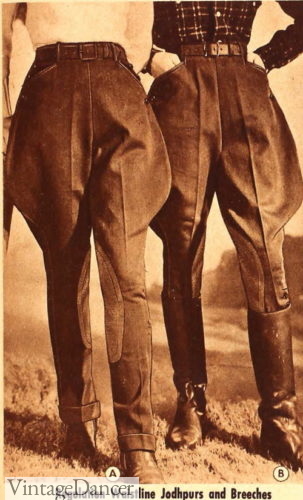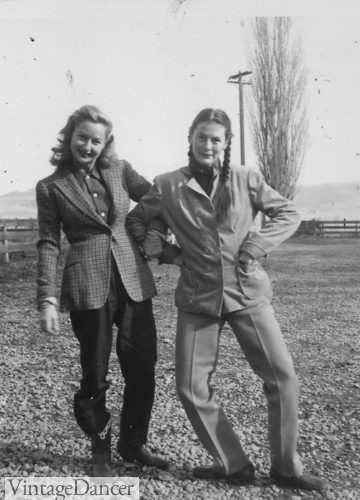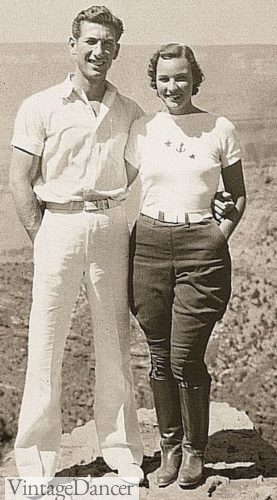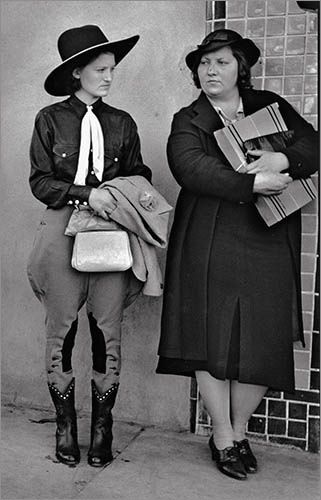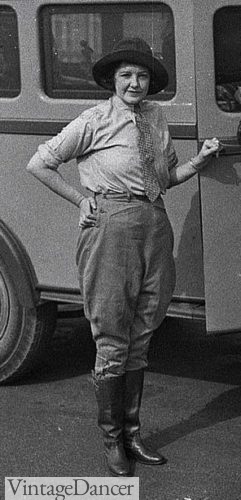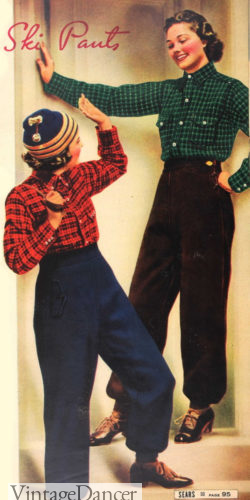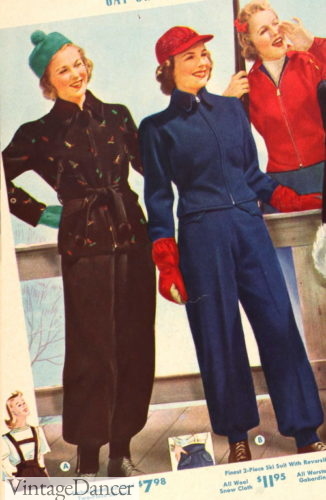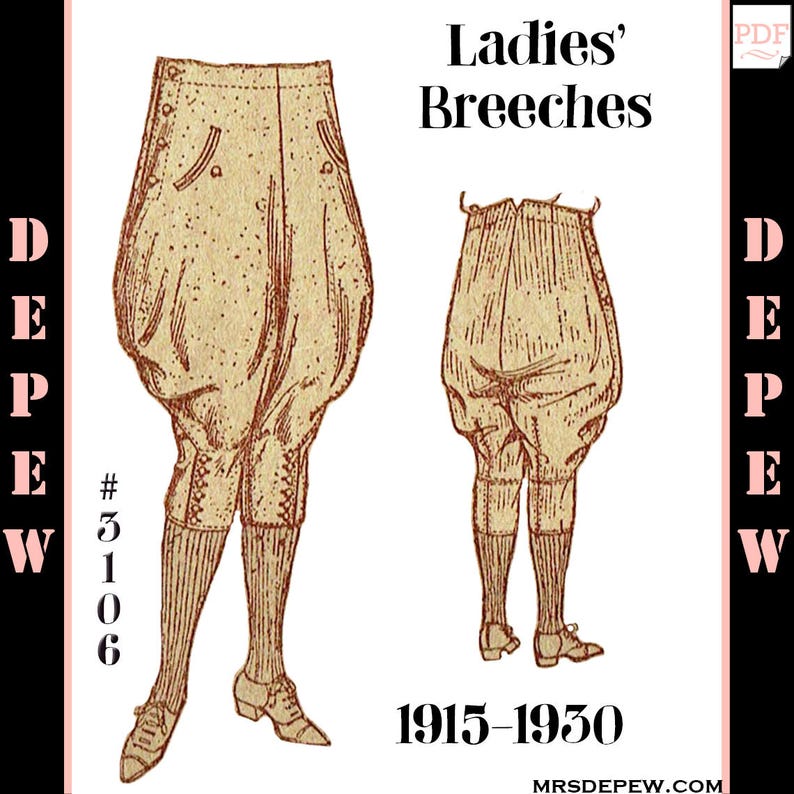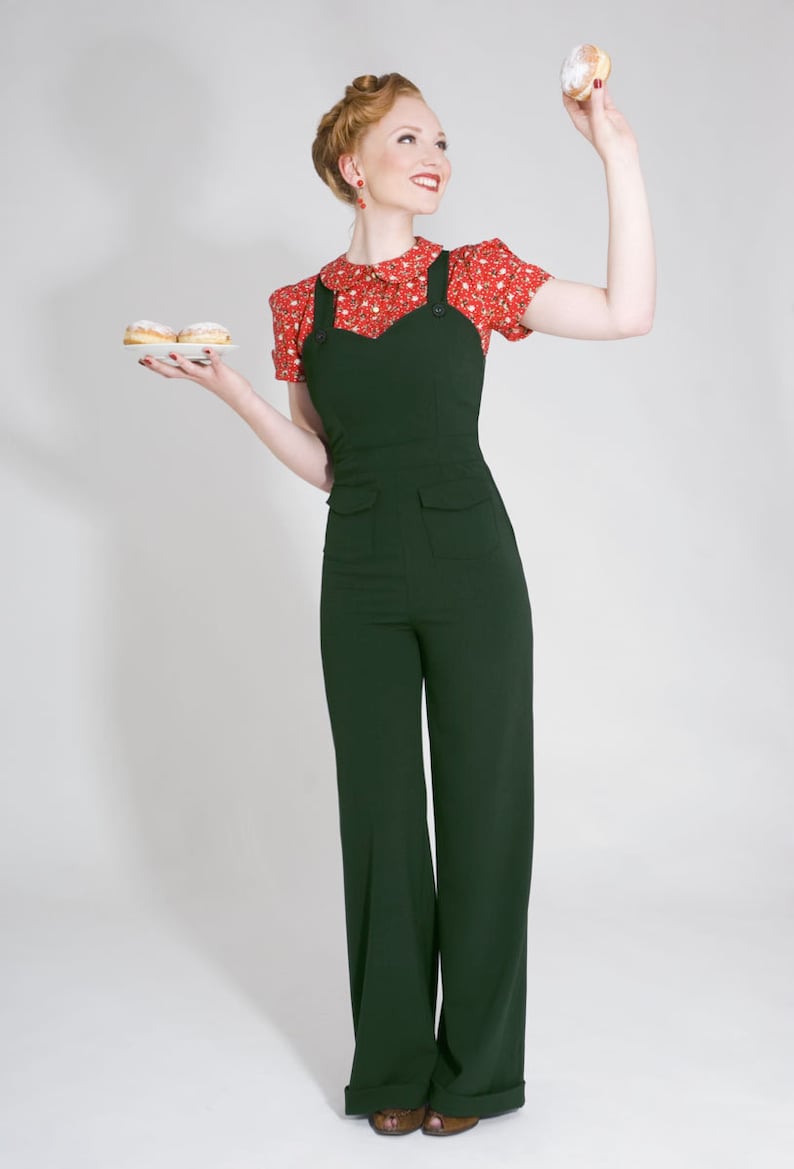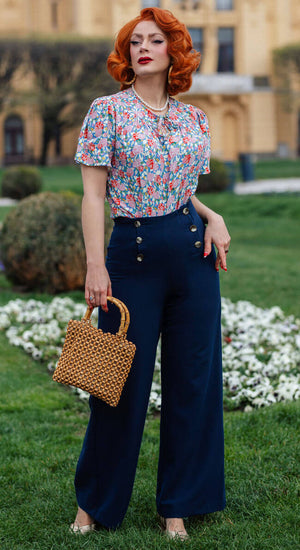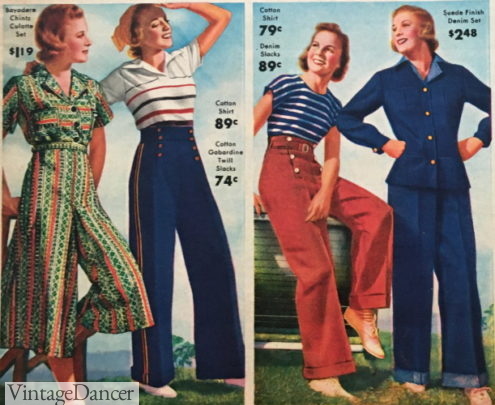
1938 Women’s Casual Culottes and Long Pants
By the 1930s, pants for lounging at home, pants worn for casual beach attire, and sport pants were a regular part of everyday fashion. In the 1920s pants for women were limited to knickers/breeches until the Beach Pajama trend began, and it was the 1930s that carried the long and wide leg slacks fad from the beach to loungewear — not just for the Stars, but for all women. As such, the use of beach pajamas influenced not only women’s sportswear but finally long pants in public.
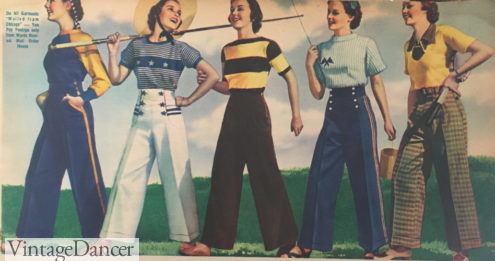
1937 Women’s Casual Slacks and Knit Tops
1930s Beach Pajamas
The new style of sleeping pajama was very similar to the beach pajama. They were called Beach Pyjamas rather than pajamas, although the latter was used more often in American English. Wide legs and a tunic top or button down blouse with a matching belt was the Asian inspired pajama style for most of the early 1930s. Nightgowns were still worn, too, but there was something less personal about pajamas that made them more likely to be worn at home without the need for a robe as a cover up.
- 1931 McCall’s Cover with Beach Pajamas
- McCall’s 1930 Very Wide Beach Pajamas with an Anchor Decal
Comfortable and glamorous, many women wore pajamas/ beach pajamas all day long to do their chores in, too. These may have been renamed Kitchen Pajamas, Gardening pajamas, or simply overalls (modern name jumpsuit) to differentiate them from sleep pajamas. The reality was they could be the same exact style, regardless of location.
- 1930 Cotton Beach Pajamas
- 1931 House Pajamas or Beach Pajamas
- 1932 Jumpsuit-Style Beach Pajamas
- 1933 Cotton House Pajamas
What tended to differentiate sleeping pajamas from beach pajamas was the material and cut. For most, sleeping and lounge pajamas were made of shiny silk, satin, or rayon, and were modest in their coverage. Meanwhile, beach pajamas were made of cotton or linen with exposed backs (more suntan!). Beach pajamas came in big fun patterns of flowers, plaid, Deco prints, and polka dots in obnoxiously bright colors (mine are orange). Sleeping pajamas were usually one or two solid jewel tone colors in comparison.
- 1933 Cotton House Pajamas
- 1935 Cotton Pajamas for House, Sleep, or Beach
- 1934 Linen Beach Pajamas
- 1934 Halter Neck Beach Pajama
- 1938 Seersucker Beach Pajama Overalls/Jumpsuit
- 1937 Pajama-Type Beach Pants
Light and airy, Beach pajamas were perfect in hot weather (and they’re amazing to dance in too!). They could be just pants, but more often they were overalls (jumpsuits) with an attached top and bottom with a V neck/scoop neck/halter top or simple short sleeve shirt. The top and bottom didn’t need to match, either. Having the look of separates was trendier in the middle years. In many cases they were two-piece garments of matching fabrics. Separate pants could be worn over a swimsuit or in town with a modest blouse.
- Chevron Beach Pajama Jumpsuit
- Colorful Beach Pajamas
The 1930s Beach Pajamas get the credit for having the widest legs. They started at a nice roomy fit and went crazy with oversized legs (24 inches? sure!) inspired by men’s Oxfords Bags of the 1920s. “Clown pants” come to my mind when I see these monstrosities. Palazzo pants is the modern name.
- Ultra Wide Leg Pants with Striped Knit Top
- Wide, Drapey Leg Pajamas
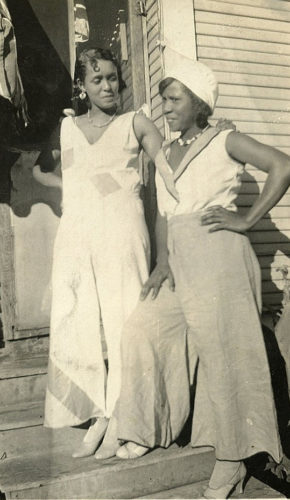
1930, Blues Musicians Geeshie Wiley and L.V. ‘Slack’ Thomas in Beach Pajamas
1930s Overalls
The idea of women wearing suspender overalls for fashion instead of while doing “men’s jobs” emerged in the 1930s. The first group of women to wear them were not women yet, but little girls. Smart mothers put their girls in durable overalls for playtime outside. Eventually, the clothing market caught on and made overalls designed for women too, complete with cute details, fun color combinations, buttons, and a sweetheart neckline.
Overalls were worn by Hollywood stars in their personal life at home on their California ranches, while traveling to beachy destinations, and possibly in movies (I couldn’t find a reference. Do you know?). This certainly helped propel the overalls fashion forward, even earning them the name “Hollywood Overalls” by some makers.
- 1937 Hollywood Overalls and Tyrolean Suspender Overalls
- 1938 Overalls and Suspender Pants
- 1938 Orange Overalls
- 1938 Women’s Overalls
These new fashionable overalls came in an assortment of primary colors in cotton twill or denim: red, green, yellow, and brown plus light, medium, and dark blues. The pants were still wide leg, but no longer folded at the cuff. Buttons replaced some metal buckles either at the top of the bib or down low on the waistband, turning them into suspender pants. The yellow overalls in the above picture are “Tyrolean slacks” with a detachable suspender bib.
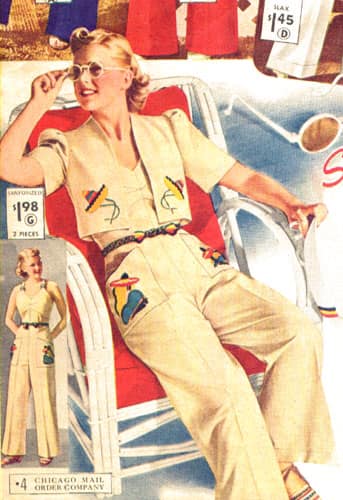
1939 ‘Farmerette’ Overalls with Sombrero Motif and Crop Jacket
Some overalls sported themes from popular vacations on the pockets, straps and matching jackets. The Mexican Riviera, Caribbean, and Southern California were especially popular.
Overalls for rough workwear came about in the very late 1930s. Women had been wearing men’s denim overalls for decades, but now manufactures were offering women’s cuts for a growing need at home and in the labor force. One piece Coveralls with a button down front and front or side buttoning pants were also made in women’s cuts. They were very useful at home in the garden or around the farm.
- 1939 Button-Down Work or Play Cotton Overalls
- 1938 Denim Overalls and Cotton Coveralls
- 1939 Heavy Denim Overalls and Cotton Coveralls
1930s Slacks
Resort wear in the 1920s was now common daywear for women in the 1930s. While they could be seen on the city streets, social etiquette generally kept them at home, for sportswear, out on vacation, or as workwear. Katherine Hepburn, Joan Crawford, Ingrid Bergman, and Marlene Dietrich were some of the first stars to wear pants in movies and out in public, thus propelling their acceptance around the world.
- Joan Crawford, 1932, Wears Sailor Pants
- Leslie Howard and Ingrid Bergman, 1938
One major influence one women’s sportwear slacks was the Navy Man’s sailor pant. These were high waisted, wide leg pants with a cuffed (and often flared) hem and buttons on the front flap or side. They were the influence for the 1960s-1970s bell bottom fad. White and navy blue were natural color offerings with contrasting buttons, leg stripes, and anchor, stripe, or sailboat motifs on one leg. Some had white rope belts, too, but most were beltless.
- 1934 White Slacks
- 1935 White Sailor Pants
- 1937 Sailor Pants
- 1937 Sailor Pants with Stripe and Matching Middy Top
- 1937 White and Navy Blue Sailor Pants
- 1938 Cotton or Denim Sailor Pants
- Sailor Themed Pants and Top
- 1930s Wide Leg Button Pants
Women’s 1930s trousers were called slacks. They did not have a front fly like men’s trousers because that was seen as too masculine. Legs were very wide — up to 24 inches with a deep seat and honestly, not the most flattering fit on petite women.
Besides sailor themes, plain wide leg slacks with a side button fastening could be worn with any casual outfit. Catalogs always sold them as sportswear/playwear, but most women wore them for puttering about the home, visiting friends, lounging by the pool, and sometimes dancing. They were usually paired with short sleeve knit shirts, polo shirts, and coordinating bolero jackets.
- 1938 Plain Blue Slacks with Side Button
- 1939 Basic Slacks
Closer to the 1940s, women’s slacks filled important roles in work (farm, factory). A more masculine look was applied to basic slacks. Waistbands with belt loops, pleats, and coin pockets made in sturdy cotton, denim, and wool met needs without sacrificing feminine style too much.
- 1939 Work Slacks with Coin Pocket and Belt
- 1939 Extra Wide Waistband with Thin Belt and Pleats
1930s Culotte Pants
In 1931, Lili Alvarez wore a trouser skirt designed by Elsa Schiaparelli to the Wimbledon Championships. They were knee length, wide leg trousers with a short overskirt. Modest yet scandalous at the same time!
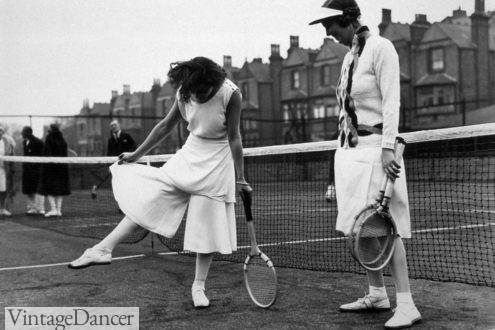
1931 Lili Alvarez in Culottes with a Skirt, designed by Elsa Schiaparelli
1930s culottes were a short pants style with a wide flowing leg. It looked like a cross between a pant and skirt. Today, culottes are also sometimes called gaucho pants and can be mid-calf or knee-length.
By the mid 1930s, culottes were made en masse, ditching the over skirt. White was the best color but tan, blue, brown, red — pretty much any color or pattern — were worn. Linen was the coolest, denim or twill the sturdiest, and rayon was the flowiest. When paired with a matching shirt top, the ensemble looked like a Culotte-jumpsuit or playsuit (with overdress).
- 1930 Linen Culottes with Sailor Buttons
- 1937 Denim Sailor Button Culottes
- 1937 Summer Culottes
To make the legs extra wide, designers placed a flat front with side buttons or a front flap with sailor buttons and A-line cut legs, with an invert pleat from the mid-thigh on down. Pleated waists came a bit later in the decade and were made up in rayon or cotton for maximum swish and sway.
- 1938 Twill Culottes and Rayon Culottes with Overdress
- 1938 Pleated Rayon Culottes Set
- 1938 Circle Dot Pattern Culottes Set
1930s Breeches and Jodhpurs
Other popular sports, hobbies, and lifestyles for women were horseback riding, hiking, hunting, fishing, and many out outdoor activities. Most used the same outfit of breeches or jodhpur pants with a belt, knit top or button down shirt, and boots. Collectively, the outfit was called riding togs.
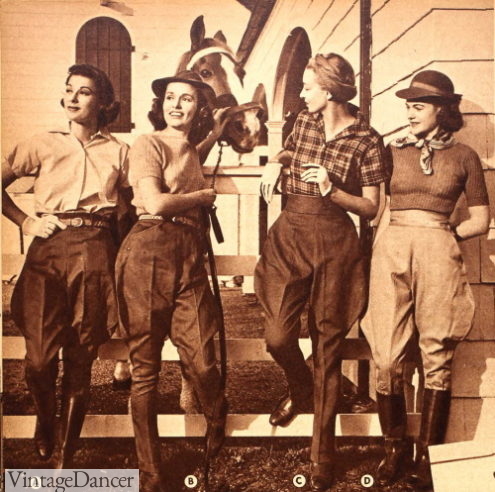
1939 Riding Togs (Outfits)
These comical pants featured a high waist, ballooned hip, and narrow legs with inside suede patches. They had been in style for over a decade. In the 1920s, women wore breeches that cuffed at the knee with tall socks. Some 1930s women continued to wear these breeches with side buttons below the knee.
The latest style was for long pants, AKA jodhpurs, with a stirrup strap worn under the boot’s sole. Calf-high lace-up boots, side lacing pull-on boots, or western style boots were worn over the pants. Short ankle Jodhpur boots or tall pull on riding boots could be worn under the pant legs.
- 1937 Extra High Waisted for Back Support
- 1938 Jodhpurs and Breeches
In country towns, it wasn’t uncommon to see women wearing “riding togs” to shop, visit a bank, or work at home in. The Rancher / Western look was a lifestyle for many American women and they dressed accordingly.
- Silliness Wearing Riding Togs
- A Casual Outfit of Riding Jodhpurs and Knit Shirt
- 1937 in Texas, a Woman Stands in Line at the Bank in her Togs
- 1935 – A Hiker (camp leader?) Wears Wool Breeches
1930s Ski Pants
For women, wearing pants was mostly a summertime clothing option. The one exception was the ribbed knit, cuffed wool ski pants with long “bloomer-like” legs. Although intended for ski and snow play, women in very cold climates wore them outside, into town, and for work — anytime dresses would not be warm enough. There were wool overalls, too.
- 1934 Red Ski Pants with Roll Neck Sweater
- 1936 Brown Ski Pants with White Blouse
- 1937 Ski Pants with Flannel Shirts
- 1939 Women’s Ski Suits
Wool ski pants were paired with warm blouses or knit pullovers, thick roll neck “ski” sweaters, and menswear style flannel shirts (in solid, check, or plaid). A matching wool ski jacket in either the belted Mackinaw or short bomber jacket style were the two best options. A pair of lace up winter snow boots was also critical. Read more about vintage winter boots here.
The wool or flannel winter slacks (not cuffed this time) came about at the very end of the 1930s, giving women year round casual comfort.
Read More
- Did Women Wear Pants in the 1920s?
- 1930s Ladies’ Bathing Suits and Swimsuits
- An Introduction to 1930s Women’s Fashion
- 1940s Women’s Pants History
- Women’s Wide Leg Pants Pictures, 1920s-1950s
Buying 1930s Style Pants
To get the 1930s pant style, you can have a pair custom made ($$$), sew a pair, or purchase modern wide leg pants. The current palazzo leg and general wide leg pants (based on the 1970s looks) can work for a 1930s inspired outfit. Certain jumpsuits can work well as Beach Pajamas too. Wool pants will be the hardest to locate in winter.
These are some new or reproduction 1930s style pants, trousers, beach pajamas, culottes, jodhpurs, and jeans to get you started:
Debbie Sessions has been teaching fashion history and helping people dress for vintage themed events since 2009. She has turned a hobby into VintageDancer.com with hundreds of well researched articles and hand picked links to vintage inspired clothing online. She aims to make dressing accurately (or not) an affordable option for all. Oh, and she dances too.
